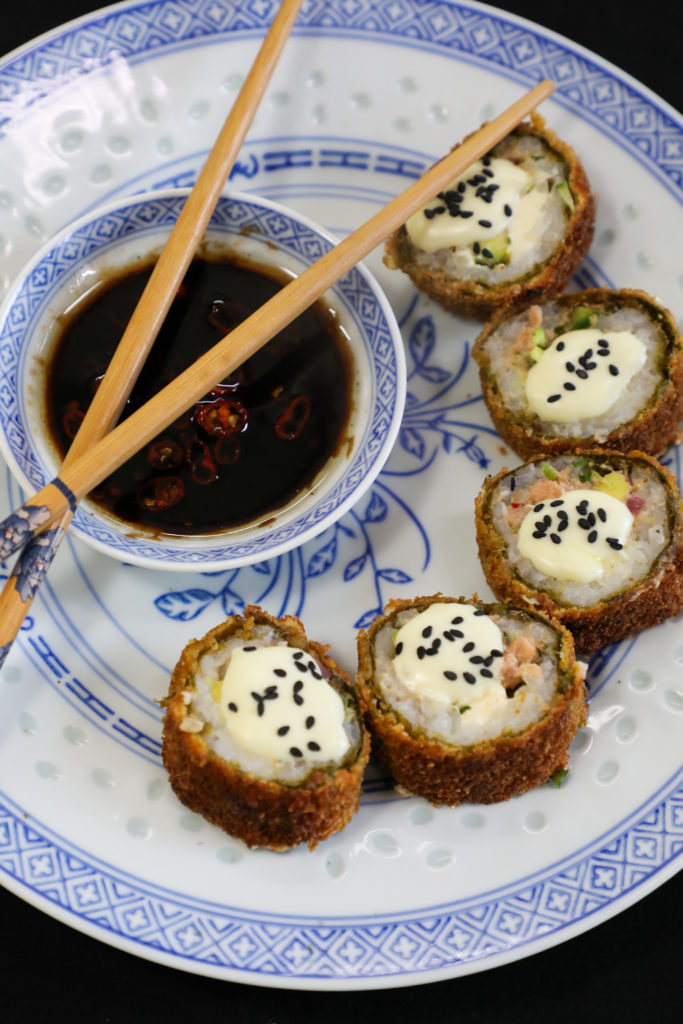By Emihle Mlotana
Originally purposed to preserve fish, sushi has evolved into a popular dish. A traditional Japanese dish originating all the way to the 1600s, has now become so popular in modern South Africa. Allow me to take you on a palatable and succulent excursion into the world of fried sushi!
In the heart of Durban’s ever-evolving culinary landscape, a surprising new trend is fried sushi, finding its way onto menus and into local conversations. This crispy, golden twist on the traditional Japanese delicacy is not only delighting taste buds but also challenging long-held perceptions of what sushi could be. For South Africans who may be shy at the thought of raw fish, fried sushi is a warm, crunchy invitation to try Japanese cuisine.
Sushi’s story begins over a thousand years ago in Southeast Asia where fish was preserved by fermenting it with rice and salt in an early form known as narezushi. Over the years, sushi evolved into the fresh, vinegared rice and raw fish combination that defines the modern Japanese dish. Fried sushi, however, is a relatively recent innovation. It emerged in the United States of America as part of western world’s adaptation of Japanese cuisine, and chefs began deep-frying sushi rolls to make them appealing to local palates. This created a new type of dish – a blend of the refined flavour of traditional sushi with the crispy indulgence of tempura. This fusion food is now popular across the globe.

Fried sushi rolls accompanied by a side of soy sauce Image: Sizwe Ezeogu
In South Africa, foodies are often eager to try out this variation to the traditional sushi. Fried sushi fits seamlessly into Durban’s food scene because it offers something that feels both new and familiar. It speaks to Durban’s openness to global influences while remaining grounded in local tastes.
Fried sushi typically starts with a common sushi roll, wrapped in seaweed and filled with ingredients such as seasoned sushi rice, avocado, cucumber, cream cheese, and crab sticks or smoked salmon. The roll is then dipped in a light batter, coated in crispy panko breadcrumbs, and deep-fried until it turns a golden colour. It is often accompanied with spicy mayo, soy sauce, or sweet eel sauce, which add flavour. This cooking method allows for a pleasing contrast between the crunchy exterior and creamy interior. The result is a delicious texture that appeals to everyone – be it people new to sushi or seasoned enthusiasts.
For Nkosi Magwaza, a final-year Food and Nutrition student at the Durban University of Technology (DUT), fried sushi became more than just a dish—it was a statement. Tasked with preparing an international meal for a practical assignment, Magwaza chose fried sushi to challenge the impression that sushi is inaccessible or intimidating.
“I wanted to make something that felt global but still easy to approach. Most people in my community think that sushi is just raw fish and seaweed,” Magwaza explained.
Magwaza adapted the recipe using locally available ingredients, including hake, avocado, and a soy sauce with a fusion of chili peppers.
For those hesitant to taste or eat raw fish, fried sushi provides a cooked alternative that is a lot easier to embrace. The crunchy coating and soft filling are a perfect, tempting match, which one can change to suit their taste. In a country where food is deeply tied to identity, culture and community, fried sushi offers a way to explore international cuisine without forsaking cultural awareness.
Lwandile Hlekwayo, a food enthusiast with a keen interest in culinary trends, weighed in on the unique twist of fried sushi.
“I think fried sushi is just different and I mean that in a good way. It’s really great for someone who’s just getting into seafood and doesn’t have the palate to handle traditional sushi or other foods like prawns and lobster,” Hlekwayo explained.
He described fried sushi as comfort food disguised as Japanese cuisine, and a totally different experience from traditional sushi.
Durban’s sushi selection is growing, and fried sushi is increasingly featured on menus across the city. Franchises like Ocean Basket, John Dory’s and Tommy’s Sushi among others, are at the forefront, offering fried rolls that are generous, satisfying, and full of flavour at attainable prices. These places are creating a new type of sushi experience in South Africa, making it an easier and more viable option for everyone to enjoy.
Fried sushi is a staple food, not just a culinary trend. It is a bridge between cultures, a conversation starter, and a delicious way to rethink tradition. In Durban, it is carving out its own niche that reflects the city’s love of daring tastes and blending international cuisines. Whether you are a sushi sceptic or a seasoned sashimi fan, fried sushi is a modern evolution of an ancient dish. So, go ahead – take a bite and let the crunch convince you!


